Nursing Report: Preventing Healthcare-Associated Infections (HAIs)
VerifiedAdded on 2022/09/14
|11
|3083
|19
Report
AI Summary
This nursing report focuses on the Australian Commission on Safety and Quality in Health Care's Standard 3, "Preventing and Controlling Healthcare-Associated Infection Standard," emphasizing the critical role of hand hygiene in reducing healthcare-associated infections (HAIs). The report discusses the importance of quality and safety in Australian healthcare, highlighting the impact of HAIs on patient outcomes and the effectiveness of hand hygiene regimes, including WHO guidelines. It explores the application of the Donabedian model (structure, process, and outcomes) to assess hand hygiene implementation and evaluate its impact using methods such as ultraviolet spectrum markers and automated monitoring systems. The report concludes that hand hygiene is vital for improving patient safety and reducing the length of hospital stays and costs, summarizing the benefits of effective infection control measures and the use of multi-modal strategies to enhance compliance and achieve better outcomes. The report is a great resource for students, and Desklib provides past papers and solved assignments for students.
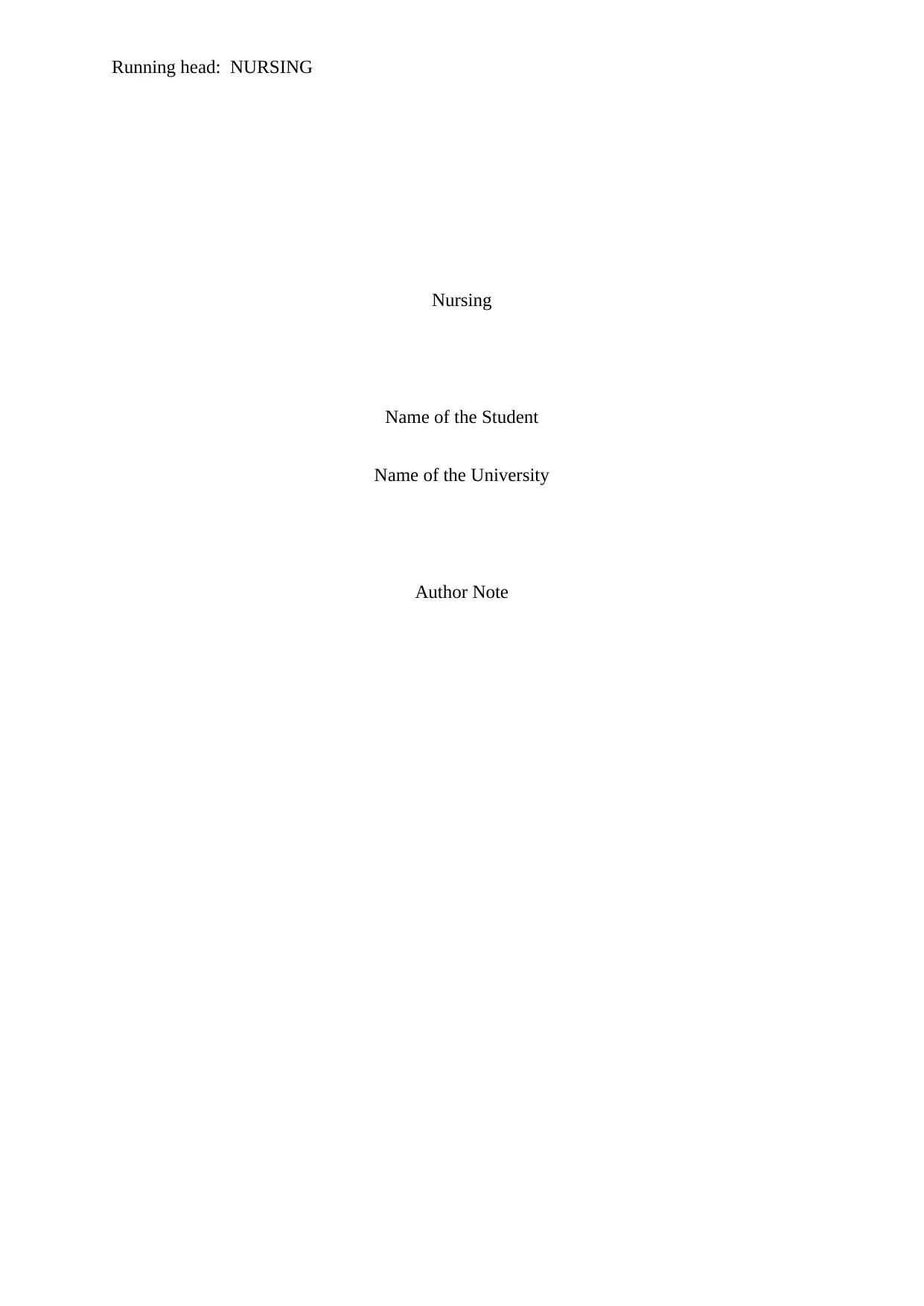
Running head: NURSING
Nursing
Name of the Student
Name of the University
Author Note
Nursing
Name of the Student
Name of the University
Author Note
Paraphrase This Document
Need a fresh take? Get an instant paraphrase of this document with our AI Paraphraser
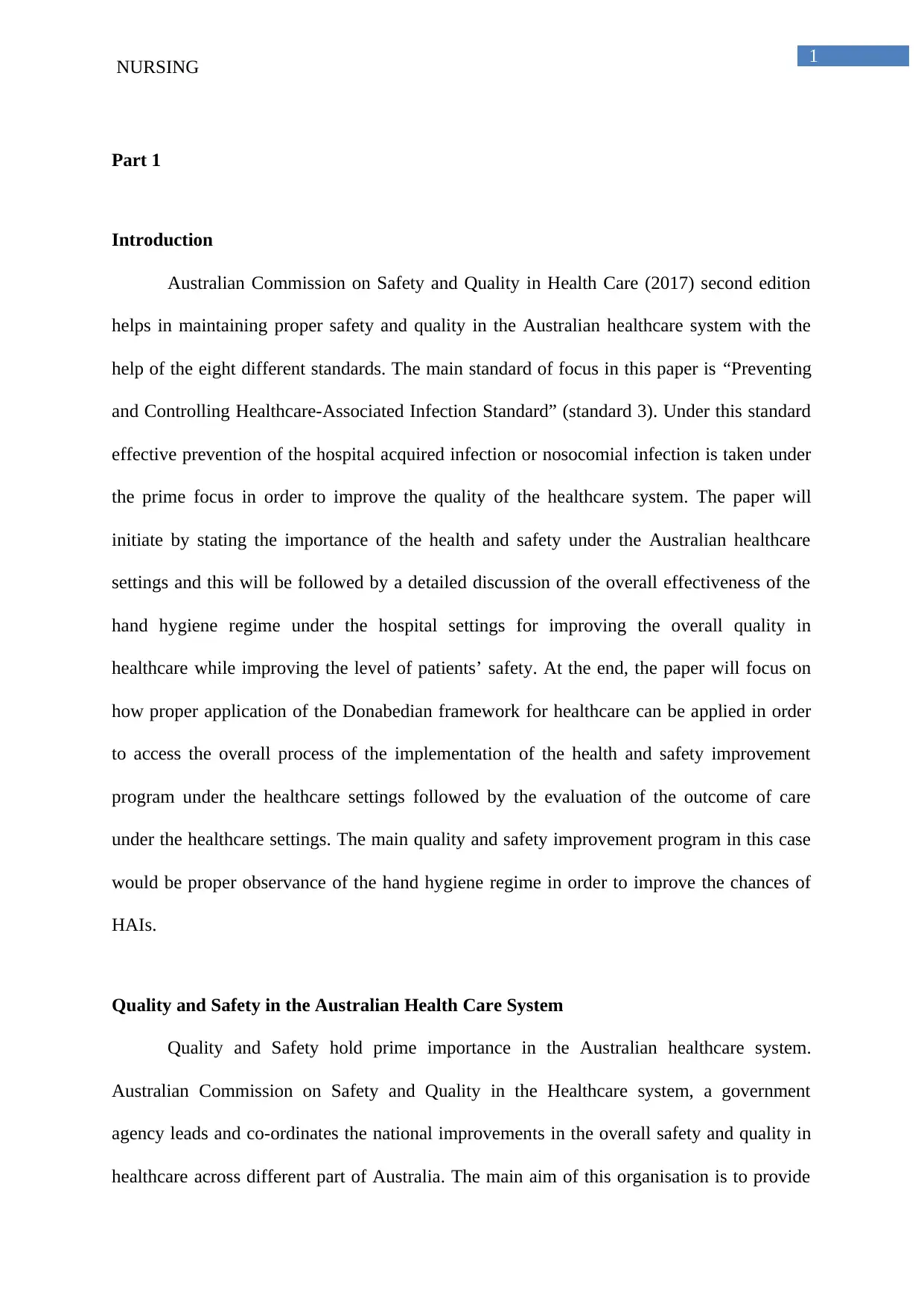
1
NURSING
Part 1
Introduction
Australian Commission on Safety and Quality in Health Care (2017) second edition
helps in maintaining proper safety and quality in the Australian healthcare system with the
help of the eight different standards. The main standard of focus in this paper is “Preventing
and Controlling Healthcare-Associated Infection Standard” (standard 3). Under this standard
effective prevention of the hospital acquired infection or nosocomial infection is taken under
the prime focus in order to improve the quality of the healthcare system. The paper will
initiate by stating the importance of the health and safety under the Australian healthcare
settings and this will be followed by a detailed discussion of the overall effectiveness of the
hand hygiene regime under the hospital settings for improving the overall quality in
healthcare while improving the level of patients’ safety. At the end, the paper will focus on
how proper application of the Donabedian framework for healthcare can be applied in order
to access the overall process of the implementation of the health and safety improvement
program under the healthcare settings followed by the evaluation of the outcome of care
under the healthcare settings. The main quality and safety improvement program in this case
would be proper observance of the hand hygiene regime in order to improve the chances of
HAIs.
Quality and Safety in the Australian Health Care System
Quality and Safety hold prime importance in the Australian healthcare system.
Australian Commission on Safety and Quality in the Healthcare system, a government
agency leads and co-ordinates the national improvements in the overall safety and quality in
healthcare across different part of Australia. The main aim of this organisation is to provide
NURSING
Part 1
Introduction
Australian Commission on Safety and Quality in Health Care (2017) second edition
helps in maintaining proper safety and quality in the Australian healthcare system with the
help of the eight different standards. The main standard of focus in this paper is “Preventing
and Controlling Healthcare-Associated Infection Standard” (standard 3). Under this standard
effective prevention of the hospital acquired infection or nosocomial infection is taken under
the prime focus in order to improve the quality of the healthcare system. The paper will
initiate by stating the importance of the health and safety under the Australian healthcare
settings and this will be followed by a detailed discussion of the overall effectiveness of the
hand hygiene regime under the hospital settings for improving the overall quality in
healthcare while improving the level of patients’ safety. At the end, the paper will focus on
how proper application of the Donabedian framework for healthcare can be applied in order
to access the overall process of the implementation of the health and safety improvement
program under the healthcare settings followed by the evaluation of the outcome of care
under the healthcare settings. The main quality and safety improvement program in this case
would be proper observance of the hand hygiene regime in order to improve the chances of
HAIs.
Quality and Safety in the Australian Health Care System
Quality and Safety hold prime importance in the Australian healthcare system.
Australian Commission on Safety and Quality in the Healthcare system, a government
agency leads and co-ordinates the national improvements in the overall safety and quality in
healthcare across different part of Australia. The main aim of this organisation is to provide
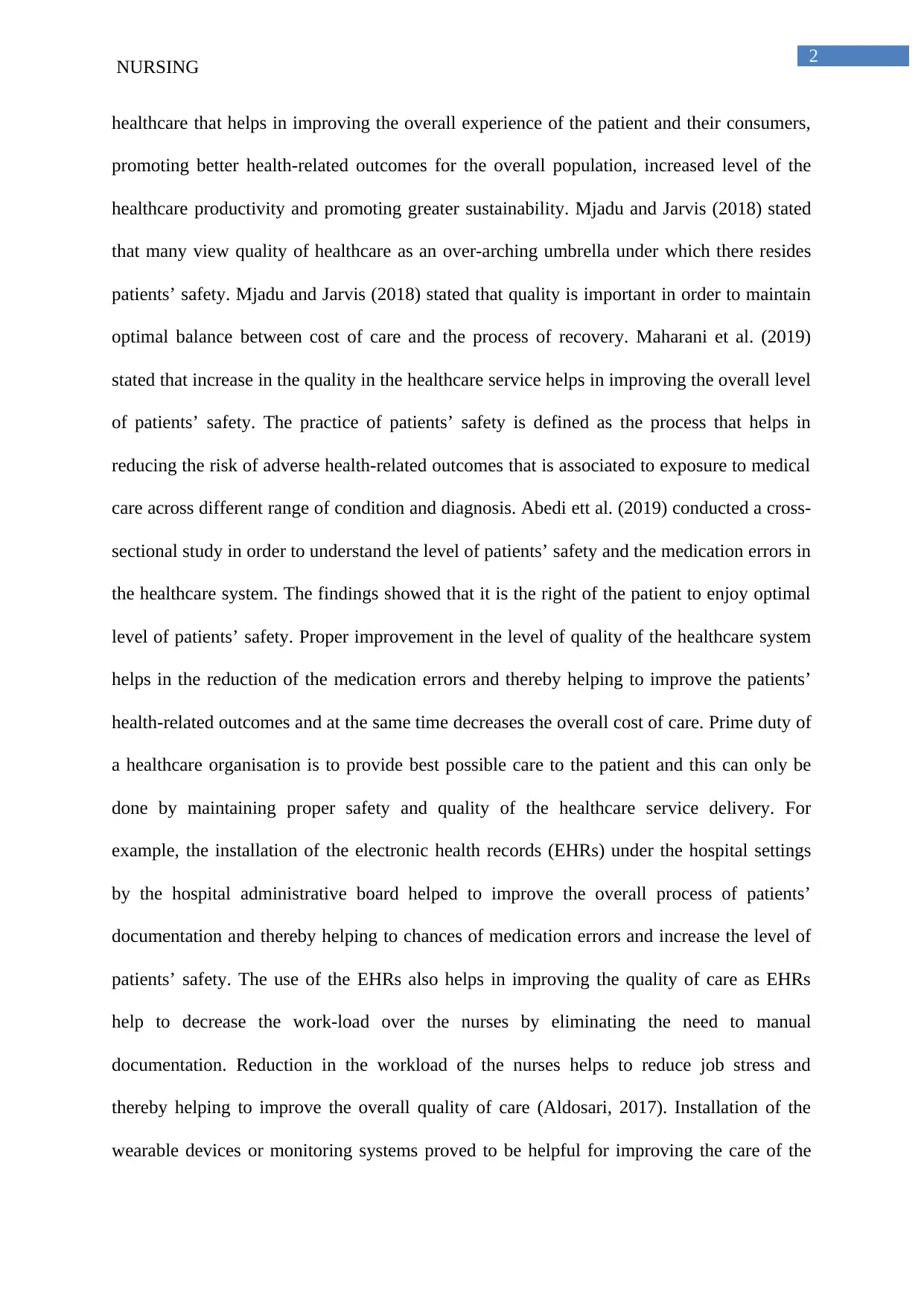
2
NURSING
healthcare that helps in improving the overall experience of the patient and their consumers,
promoting better health-related outcomes for the overall population, increased level of the
healthcare productivity and promoting greater sustainability. Mjadu and Jarvis (2018) stated
that many view quality of healthcare as an over-arching umbrella under which there resides
patients’ safety. Mjadu and Jarvis (2018) stated that quality is important in order to maintain
optimal balance between cost of care and the process of recovery. Maharani et al. (2019)
stated that increase in the quality in the healthcare service helps in improving the overall level
of patients’ safety. The practice of patients’ safety is defined as the process that helps in
reducing the risk of adverse health-related outcomes that is associated to exposure to medical
care across different range of condition and diagnosis. Abedi ett al. (2019) conducted a cross-
sectional study in order to understand the level of patients’ safety and the medication errors in
the healthcare system. The findings showed that it is the right of the patient to enjoy optimal
level of patients’ safety. Proper improvement in the level of quality of the healthcare system
helps in the reduction of the medication errors and thereby helping to improve the patients’
health-related outcomes and at the same time decreases the overall cost of care. Prime duty of
a healthcare organisation is to provide best possible care to the patient and this can only be
done by maintaining proper safety and quality of the healthcare service delivery. For
example, the installation of the electronic health records (EHRs) under the hospital settings
by the hospital administrative board helped to improve the overall process of patients’
documentation and thereby helping to chances of medication errors and increase the level of
patients’ safety. The use of the EHRs also helps in improving the quality of care as EHRs
help to decrease the work-load over the nurses by eliminating the need to manual
documentation. Reduction in the workload of the nurses helps to reduce job stress and
thereby helping to improve the overall quality of care (Aldosari, 2017). Installation of the
wearable devices or monitoring systems proved to be helpful for improving the care of the
NURSING
healthcare that helps in improving the overall experience of the patient and their consumers,
promoting better health-related outcomes for the overall population, increased level of the
healthcare productivity and promoting greater sustainability. Mjadu and Jarvis (2018) stated
that many view quality of healthcare as an over-arching umbrella under which there resides
patients’ safety. Mjadu and Jarvis (2018) stated that quality is important in order to maintain
optimal balance between cost of care and the process of recovery. Maharani et al. (2019)
stated that increase in the quality in the healthcare service helps in improving the overall level
of patients’ safety. The practice of patients’ safety is defined as the process that helps in
reducing the risk of adverse health-related outcomes that is associated to exposure to medical
care across different range of condition and diagnosis. Abedi ett al. (2019) conducted a cross-
sectional study in order to understand the level of patients’ safety and the medication errors in
the healthcare system. The findings showed that it is the right of the patient to enjoy optimal
level of patients’ safety. Proper improvement in the level of quality of the healthcare system
helps in the reduction of the medication errors and thereby helping to improve the patients’
health-related outcomes and at the same time decreases the overall cost of care. Prime duty of
a healthcare organisation is to provide best possible care to the patient and this can only be
done by maintaining proper safety and quality of the healthcare service delivery. For
example, the installation of the electronic health records (EHRs) under the hospital settings
by the hospital administrative board helped to improve the overall process of patients’
documentation and thereby helping to chances of medication errors and increase the level of
patients’ safety. The use of the EHRs also helps in improving the quality of care as EHRs
help to decrease the work-load over the nurses by eliminating the need to manual
documentation. Reduction in the workload of the nurses helps to reduce job stress and
thereby helping to improve the overall quality of care (Aldosari, 2017). Installation of the
wearable devices or monitoring systems proved to be helpful for improving the care of the
⊘ This is a preview!⊘
Do you want full access?
Subscribe today to unlock all pages.

Trusted by 1+ million students worldwide
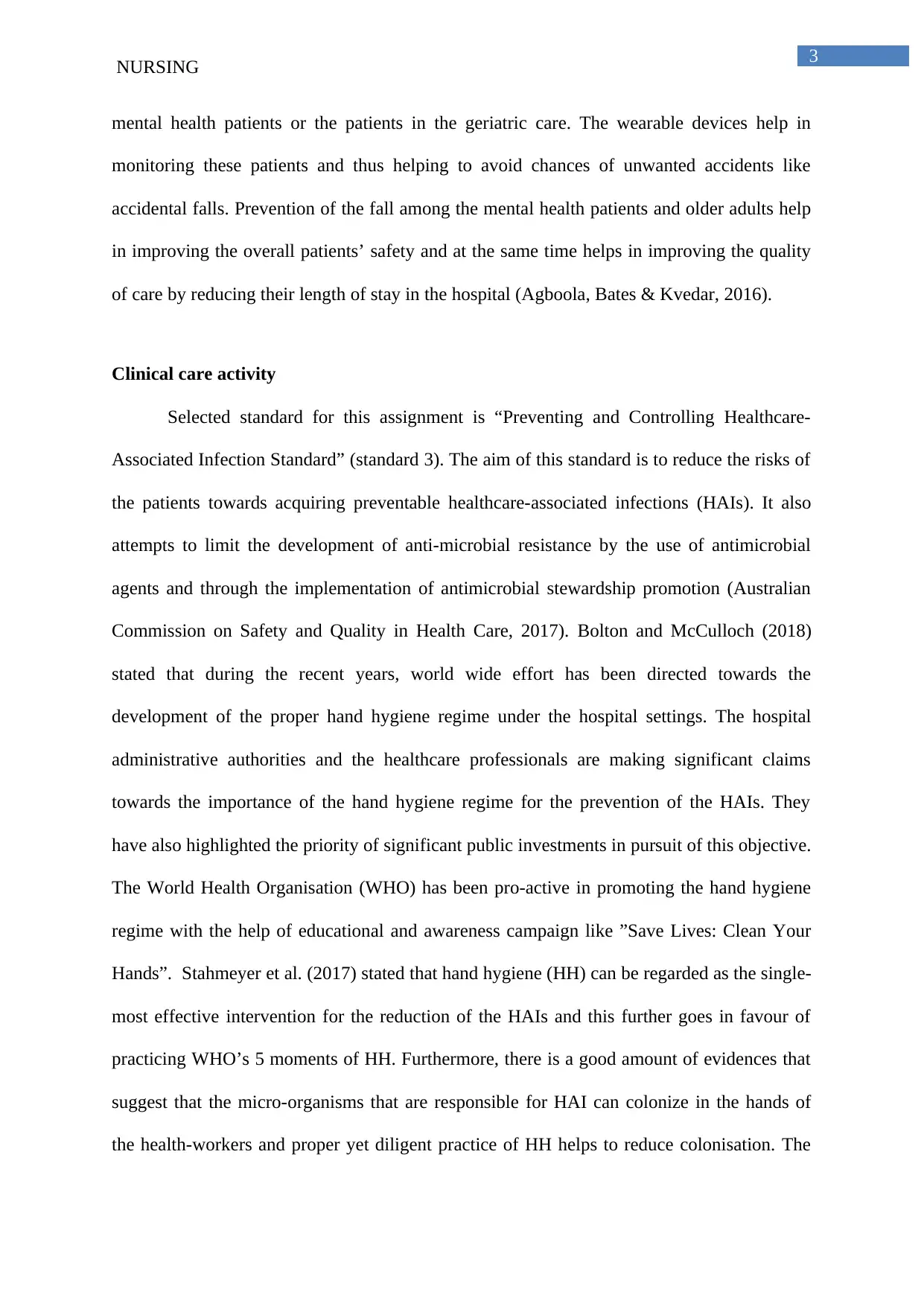
3
NURSING
mental health patients or the patients in the geriatric care. The wearable devices help in
monitoring these patients and thus helping to avoid chances of unwanted accidents like
accidental falls. Prevention of the fall among the mental health patients and older adults help
in improving the overall patients’ safety and at the same time helps in improving the quality
of care by reducing their length of stay in the hospital (Agboola, Bates & Kvedar, 2016).
Clinical care activity
Selected standard for this assignment is “Preventing and Controlling Healthcare-
Associated Infection Standard” (standard 3). The aim of this standard is to reduce the risks of
the patients towards acquiring preventable healthcare-associated infections (HAIs). It also
attempts to limit the development of anti-microbial resistance by the use of antimicrobial
agents and through the implementation of antimicrobial stewardship promotion (Australian
Commission on Safety and Quality in Health Care, 2017). Bolton and McCulloch (2018)
stated that during the recent years, world wide effort has been directed towards the
development of the proper hand hygiene regime under the hospital settings. The hospital
administrative authorities and the healthcare professionals are making significant claims
towards the importance of the hand hygiene regime for the prevention of the HAIs. They
have also highlighted the priority of significant public investments in pursuit of this objective.
The World Health Organisation (WHO) has been pro-active in promoting the hand hygiene
regime with the help of educational and awareness campaign like ”Save Lives: Clean Your
Hands”. Stahmeyer et al. (2017) stated that hand hygiene (HH) can be regarded as the single-
most effective intervention for the reduction of the HAIs and this further goes in favour of
practicing WHO’s 5 moments of HH. Furthermore, there is a good amount of evidences that
suggest that the micro-organisms that are responsible for HAI can colonize in the hands of
the health-workers and proper yet diligent practice of HH helps to reduce colonisation. The
NURSING
mental health patients or the patients in the geriatric care. The wearable devices help in
monitoring these patients and thus helping to avoid chances of unwanted accidents like
accidental falls. Prevention of the fall among the mental health patients and older adults help
in improving the overall patients’ safety and at the same time helps in improving the quality
of care by reducing their length of stay in the hospital (Agboola, Bates & Kvedar, 2016).
Clinical care activity
Selected standard for this assignment is “Preventing and Controlling Healthcare-
Associated Infection Standard” (standard 3). The aim of this standard is to reduce the risks of
the patients towards acquiring preventable healthcare-associated infections (HAIs). It also
attempts to limit the development of anti-microbial resistance by the use of antimicrobial
agents and through the implementation of antimicrobial stewardship promotion (Australian
Commission on Safety and Quality in Health Care, 2017). Bolton and McCulloch (2018)
stated that during the recent years, world wide effort has been directed towards the
development of the proper hand hygiene regime under the hospital settings. The hospital
administrative authorities and the healthcare professionals are making significant claims
towards the importance of the hand hygiene regime for the prevention of the HAIs. They
have also highlighted the priority of significant public investments in pursuit of this objective.
The World Health Organisation (WHO) has been pro-active in promoting the hand hygiene
regime with the help of educational and awareness campaign like ”Save Lives: Clean Your
Hands”. Stahmeyer et al. (2017) stated that hand hygiene (HH) can be regarded as the single-
most effective intervention for the reduction of the HAIs and this further goes in favour of
practicing WHO’s 5 moments of HH. Furthermore, there is a good amount of evidences that
suggest that the micro-organisms that are responsible for HAI can colonize in the hands of
the health-workers and proper yet diligent practice of HH helps to reduce colonisation. The
Paraphrase This Document
Need a fresh take? Get an instant paraphrase of this document with our AI Paraphraser
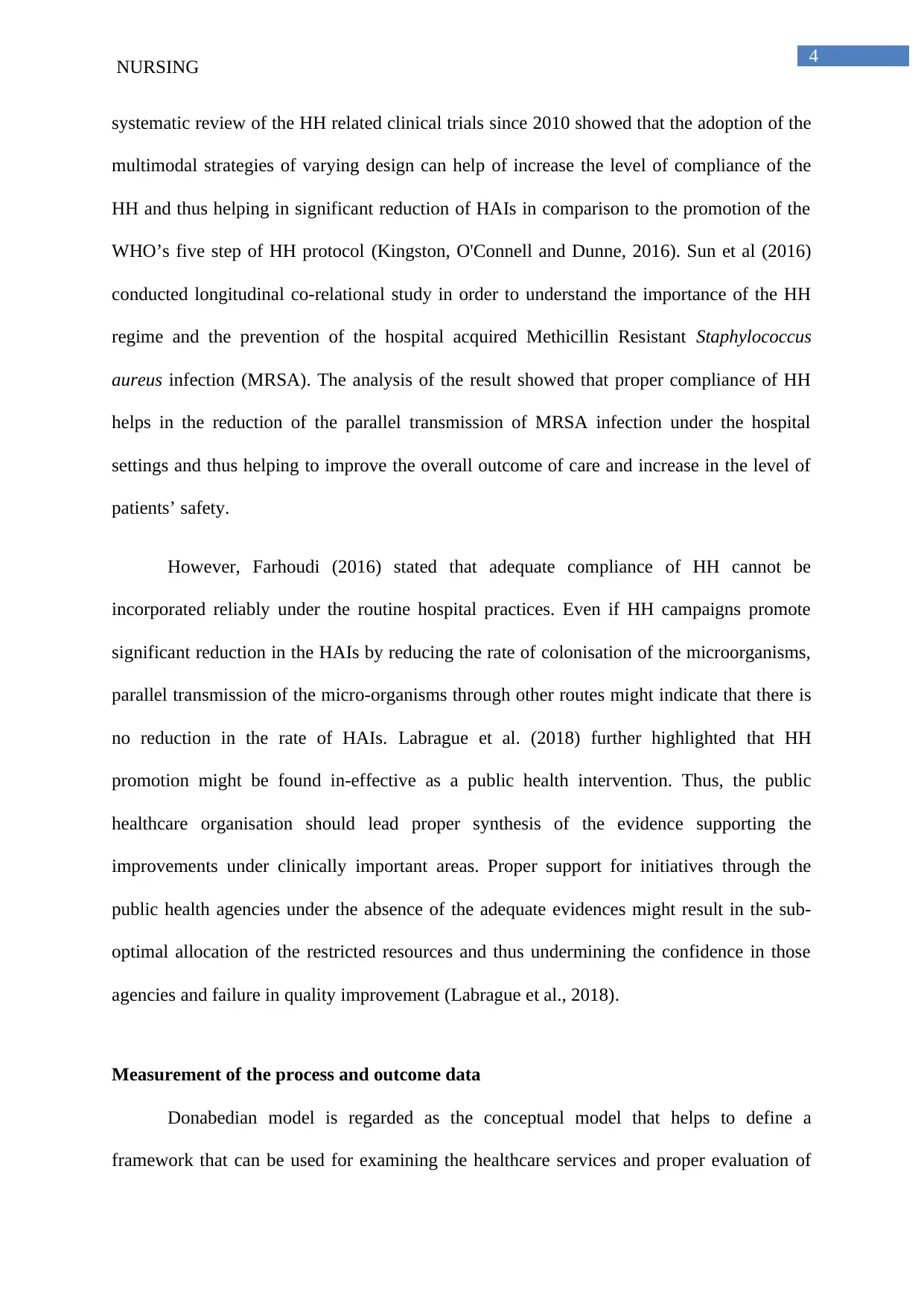
4
NURSING
systematic review of the HH related clinical trials since 2010 showed that the adoption of the
multimodal strategies of varying design can help of increase the level of compliance of the
HH and thus helping in significant reduction of HAIs in comparison to the promotion of the
WHO’s five step of HH protocol (Kingston, O'Connell and Dunne, 2016). Sun et al (2016)
conducted longitudinal co-relational study in order to understand the importance of the HH
regime and the prevention of the hospital acquired Methicillin Resistant Staphylococcus
aureus infection (MRSA). The analysis of the result showed that proper compliance of HH
helps in the reduction of the parallel transmission of MRSA infection under the hospital
settings and thus helping to improve the overall outcome of care and increase in the level of
patients’ safety.
However, Farhoudi (2016) stated that adequate compliance of HH cannot be
incorporated reliably under the routine hospital practices. Even if HH campaigns promote
significant reduction in the HAIs by reducing the rate of colonisation of the microorganisms,
parallel transmission of the micro-organisms through other routes might indicate that there is
no reduction in the rate of HAIs. Labrague et al. (2018) further highlighted that HH
promotion might be found in-effective as a public health intervention. Thus, the public
healthcare organisation should lead proper synthesis of the evidence supporting the
improvements under clinically important areas. Proper support for initiatives through the
public health agencies under the absence of the adequate evidences might result in the sub-
optimal allocation of the restricted resources and thus undermining the confidence in those
agencies and failure in quality improvement (Labrague et al., 2018).
Measurement of the process and outcome data
Donabedian model is regarded as the conceptual model that helps to define a
framework that can be used for examining the healthcare services and proper evaluation of
NURSING
systematic review of the HH related clinical trials since 2010 showed that the adoption of the
multimodal strategies of varying design can help of increase the level of compliance of the
HH and thus helping in significant reduction of HAIs in comparison to the promotion of the
WHO’s five step of HH protocol (Kingston, O'Connell and Dunne, 2016). Sun et al (2016)
conducted longitudinal co-relational study in order to understand the importance of the HH
regime and the prevention of the hospital acquired Methicillin Resistant Staphylococcus
aureus infection (MRSA). The analysis of the result showed that proper compliance of HH
helps in the reduction of the parallel transmission of MRSA infection under the hospital
settings and thus helping to improve the overall outcome of care and increase in the level of
patients’ safety.
However, Farhoudi (2016) stated that adequate compliance of HH cannot be
incorporated reliably under the routine hospital practices. Even if HH campaigns promote
significant reduction in the HAIs by reducing the rate of colonisation of the microorganisms,
parallel transmission of the micro-organisms through other routes might indicate that there is
no reduction in the rate of HAIs. Labrague et al. (2018) further highlighted that HH
promotion might be found in-effective as a public health intervention. Thus, the public
healthcare organisation should lead proper synthesis of the evidence supporting the
improvements under clinically important areas. Proper support for initiatives through the
public health agencies under the absence of the adequate evidences might result in the sub-
optimal allocation of the restricted resources and thus undermining the confidence in those
agencies and failure in quality improvement (Labrague et al., 2018).
Measurement of the process and outcome data
Donabedian model is regarded as the conceptual model that helps to define a
framework that can be used for examining the healthcare services and proper evaluation of
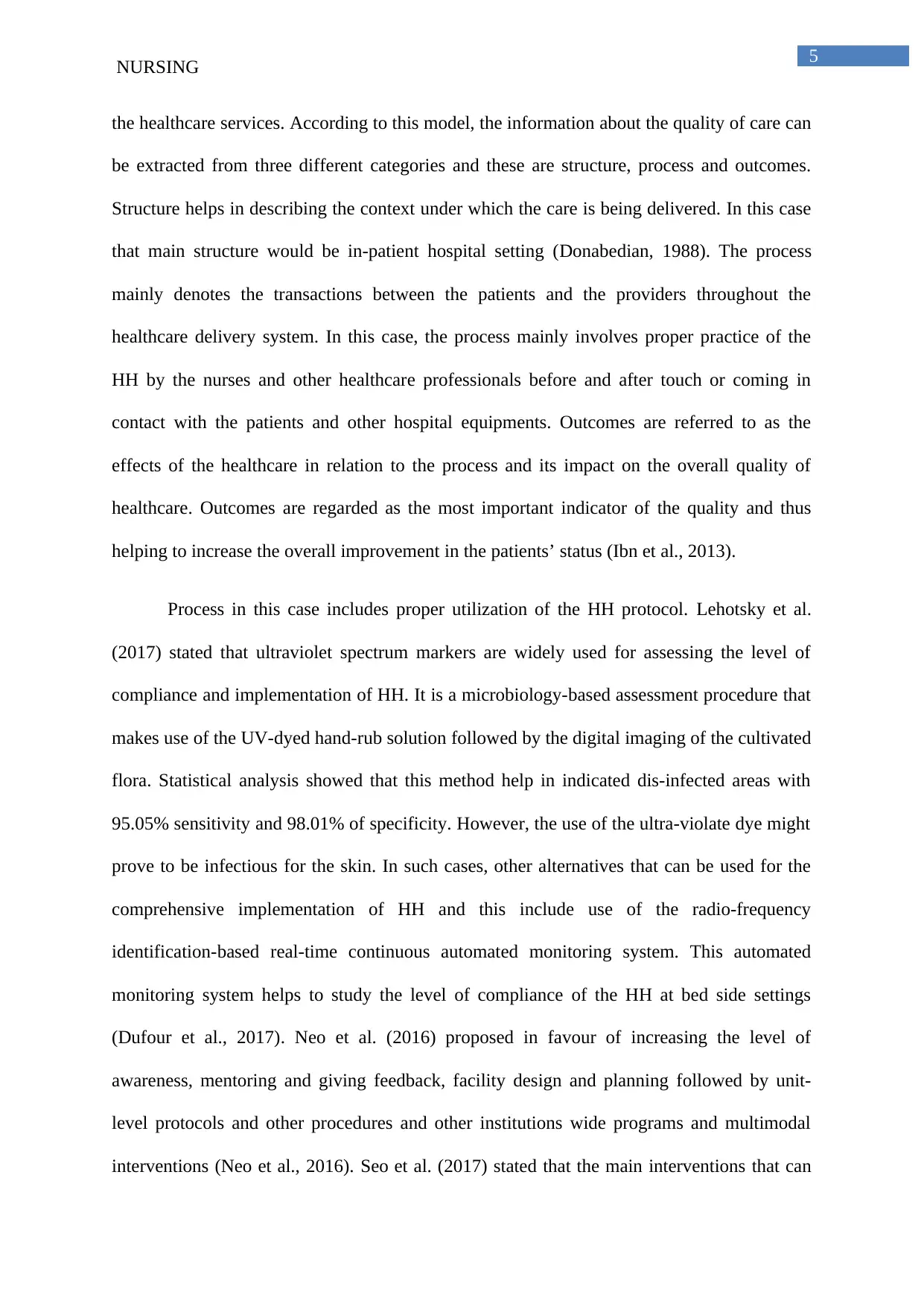
5
NURSING
the healthcare services. According to this model, the information about the quality of care can
be extracted from three different categories and these are structure, process and outcomes.
Structure helps in describing the context under which the care is being delivered. In this case
that main structure would be in-patient hospital setting (Donabedian, 1988). The process
mainly denotes the transactions between the patients and the providers throughout the
healthcare delivery system. In this case, the process mainly involves proper practice of the
HH by the nurses and other healthcare professionals before and after touch or coming in
contact with the patients and other hospital equipments. Outcomes are referred to as the
effects of the healthcare in relation to the process and its impact on the overall quality of
healthcare. Outcomes are regarded as the most important indicator of the quality and thus
helping to increase the overall improvement in the patients’ status (Ibn et al., 2013).
Process in this case includes proper utilization of the HH protocol. Lehotsky et al.
(2017) stated that ultraviolet spectrum markers are widely used for assessing the level of
compliance and implementation of HH. It is a microbiology-based assessment procedure that
makes use of the UV-dyed hand-rub solution followed by the digital imaging of the cultivated
flora. Statistical analysis showed that this method help in indicated dis-infected areas with
95.05% sensitivity and 98.01% of specificity. However, the use of the ultra-violate dye might
prove to be infectious for the skin. In such cases, other alternatives that can be used for the
comprehensive implementation of HH and this include use of the radio-frequency
identification-based real-time continuous automated monitoring system. This automated
monitoring system helps to study the level of compliance of the HH at bed side settings
(Dufour et al., 2017). Neo et al. (2016) proposed in favour of increasing the level of
awareness, mentoring and giving feedback, facility design and planning followed by unit-
level protocols and other procedures and other institutions wide programs and multimodal
interventions (Neo et al., 2016). Seo et al. (2017) stated that the main interventions that can
NURSING
the healthcare services. According to this model, the information about the quality of care can
be extracted from three different categories and these are structure, process and outcomes.
Structure helps in describing the context under which the care is being delivered. In this case
that main structure would be in-patient hospital setting (Donabedian, 1988). The process
mainly denotes the transactions between the patients and the providers throughout the
healthcare delivery system. In this case, the process mainly involves proper practice of the
HH by the nurses and other healthcare professionals before and after touch or coming in
contact with the patients and other hospital equipments. Outcomes are referred to as the
effects of the healthcare in relation to the process and its impact on the overall quality of
healthcare. Outcomes are regarded as the most important indicator of the quality and thus
helping to increase the overall improvement in the patients’ status (Ibn et al., 2013).
Process in this case includes proper utilization of the HH protocol. Lehotsky et al.
(2017) stated that ultraviolet spectrum markers are widely used for assessing the level of
compliance and implementation of HH. It is a microbiology-based assessment procedure that
makes use of the UV-dyed hand-rub solution followed by the digital imaging of the cultivated
flora. Statistical analysis showed that this method help in indicated dis-infected areas with
95.05% sensitivity and 98.01% of specificity. However, the use of the ultra-violate dye might
prove to be infectious for the skin. In such cases, other alternatives that can be used for the
comprehensive implementation of HH and this include use of the radio-frequency
identification-based real-time continuous automated monitoring system. This automated
monitoring system helps to study the level of compliance of the HH at bed side settings
(Dufour et al., 2017). Neo et al. (2016) proposed in favour of increasing the level of
awareness, mentoring and giving feedback, facility design and planning followed by unit-
level protocols and other procedures and other institutions wide programs and multimodal
interventions (Neo et al., 2016). Seo et al. (2017) stated that the main interventions that can
⊘ This is a preview!⊘
Do you want full access?
Subscribe today to unlock all pages.

Trusted by 1+ million students worldwide
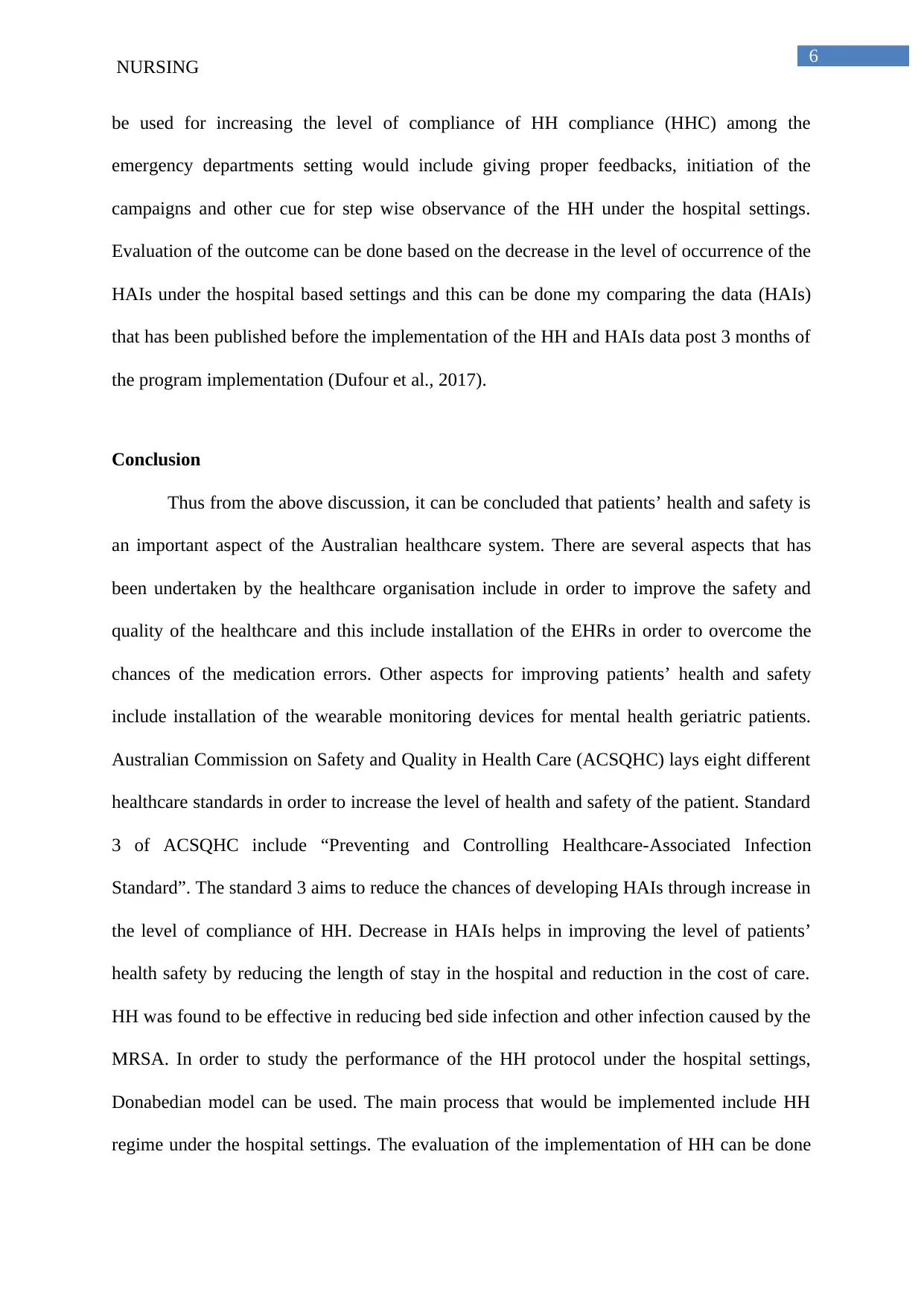
6
NURSING
be used for increasing the level of compliance of HH compliance (HHC) among the
emergency departments setting would include giving proper feedbacks, initiation of the
campaigns and other cue for step wise observance of the HH under the hospital settings.
Evaluation of the outcome can be done based on the decrease in the level of occurrence of the
HAIs under the hospital based settings and this can be done my comparing the data (HAIs)
that has been published before the implementation of the HH and HAIs data post 3 months of
the program implementation (Dufour et al., 2017).
Conclusion
Thus from the above discussion, it can be concluded that patients’ health and safety is
an important aspect of the Australian healthcare system. There are several aspects that has
been undertaken by the healthcare organisation include in order to improve the safety and
quality of the healthcare and this include installation of the EHRs in order to overcome the
chances of the medication errors. Other aspects for improving patients’ health and safety
include installation of the wearable monitoring devices for mental health geriatric patients.
Australian Commission on Safety and Quality in Health Care (ACSQHC) lays eight different
healthcare standards in order to increase the level of health and safety of the patient. Standard
3 of ACSQHC include “Preventing and Controlling Healthcare-Associated Infection
Standard”. The standard 3 aims to reduce the chances of developing HAIs through increase in
the level of compliance of HH. Decrease in HAIs helps in improving the level of patients’
health safety by reducing the length of stay in the hospital and reduction in the cost of care.
HH was found to be effective in reducing bed side infection and other infection caused by the
MRSA. In order to study the performance of the HH protocol under the hospital settings,
Donabedian model can be used. The main process that would be implemented include HH
regime under the hospital settings. The evaluation of the implementation of HH can be done
NURSING
be used for increasing the level of compliance of HH compliance (HHC) among the
emergency departments setting would include giving proper feedbacks, initiation of the
campaigns and other cue for step wise observance of the HH under the hospital settings.
Evaluation of the outcome can be done based on the decrease in the level of occurrence of the
HAIs under the hospital based settings and this can be done my comparing the data (HAIs)
that has been published before the implementation of the HH and HAIs data post 3 months of
the program implementation (Dufour et al., 2017).
Conclusion
Thus from the above discussion, it can be concluded that patients’ health and safety is
an important aspect of the Australian healthcare system. There are several aspects that has
been undertaken by the healthcare organisation include in order to improve the safety and
quality of the healthcare and this include installation of the EHRs in order to overcome the
chances of the medication errors. Other aspects for improving patients’ health and safety
include installation of the wearable monitoring devices for mental health geriatric patients.
Australian Commission on Safety and Quality in Health Care (ACSQHC) lays eight different
healthcare standards in order to increase the level of health and safety of the patient. Standard
3 of ACSQHC include “Preventing and Controlling Healthcare-Associated Infection
Standard”. The standard 3 aims to reduce the chances of developing HAIs through increase in
the level of compliance of HH. Decrease in HAIs helps in improving the level of patients’
health safety by reducing the length of stay in the hospital and reduction in the cost of care.
HH was found to be effective in reducing bed side infection and other infection caused by the
MRSA. In order to study the performance of the HH protocol under the hospital settings,
Donabedian model can be used. The main process that would be implemented include HH
regime under the hospital settings. The evaluation of the implementation of HH can be done
Paraphrase This Document
Need a fresh take? Get an instant paraphrase of this document with our AI Paraphraser
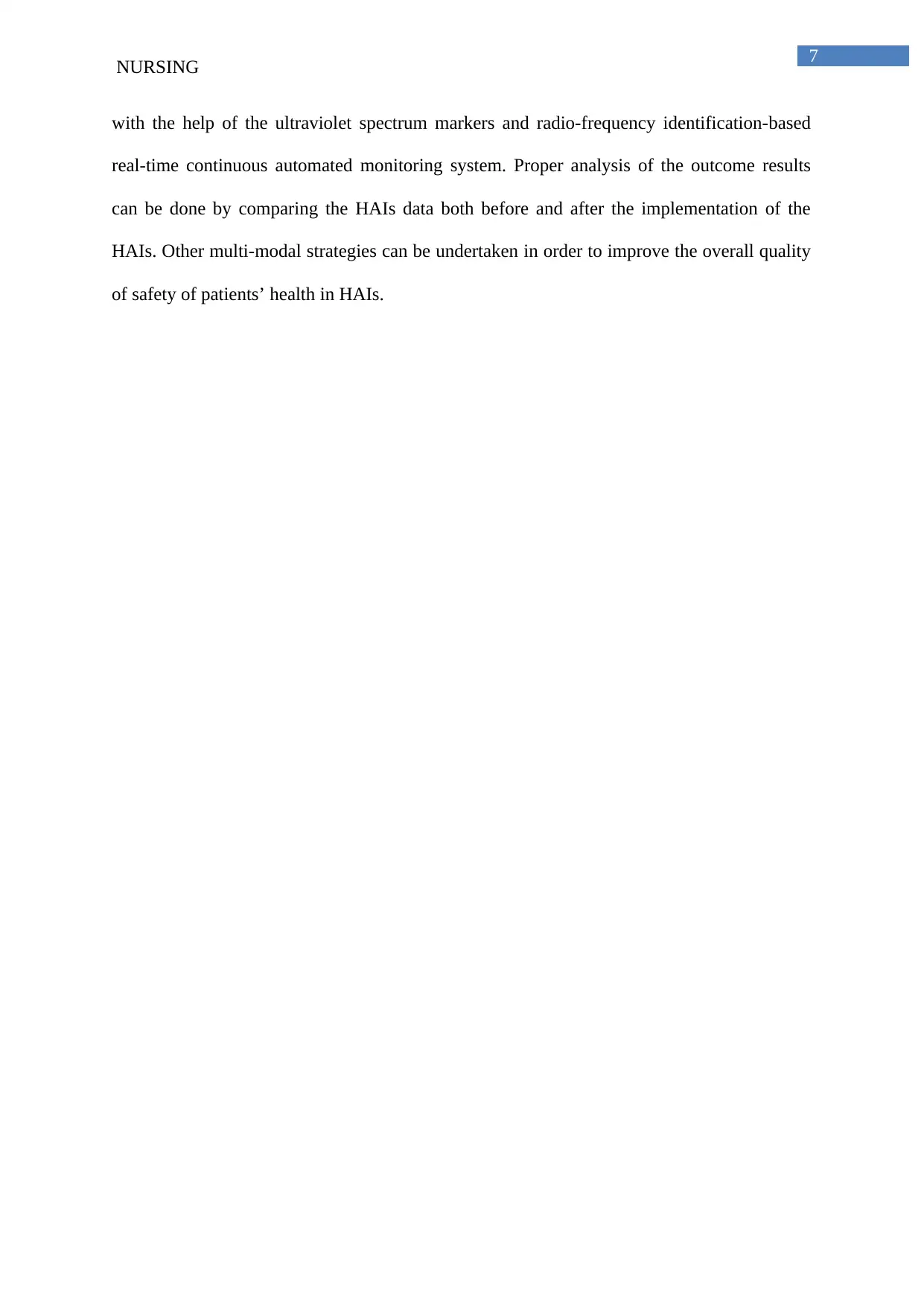
7
NURSING
with the help of the ultraviolet spectrum markers and radio-frequency identification-based
real-time continuous automated monitoring system. Proper analysis of the outcome results
can be done by comparing the HAIs data both before and after the implementation of the
HAIs. Other multi-modal strategies can be undertaken in order to improve the overall quality
of safety of patients’ health in HAIs.
NURSING
with the help of the ultraviolet spectrum markers and radio-frequency identification-based
real-time continuous automated monitoring system. Proper analysis of the outcome results
can be done by comparing the HAIs data both before and after the implementation of the
HAIs. Other multi-modal strategies can be undertaken in order to improve the overall quality
of safety of patients’ health in HAIs.
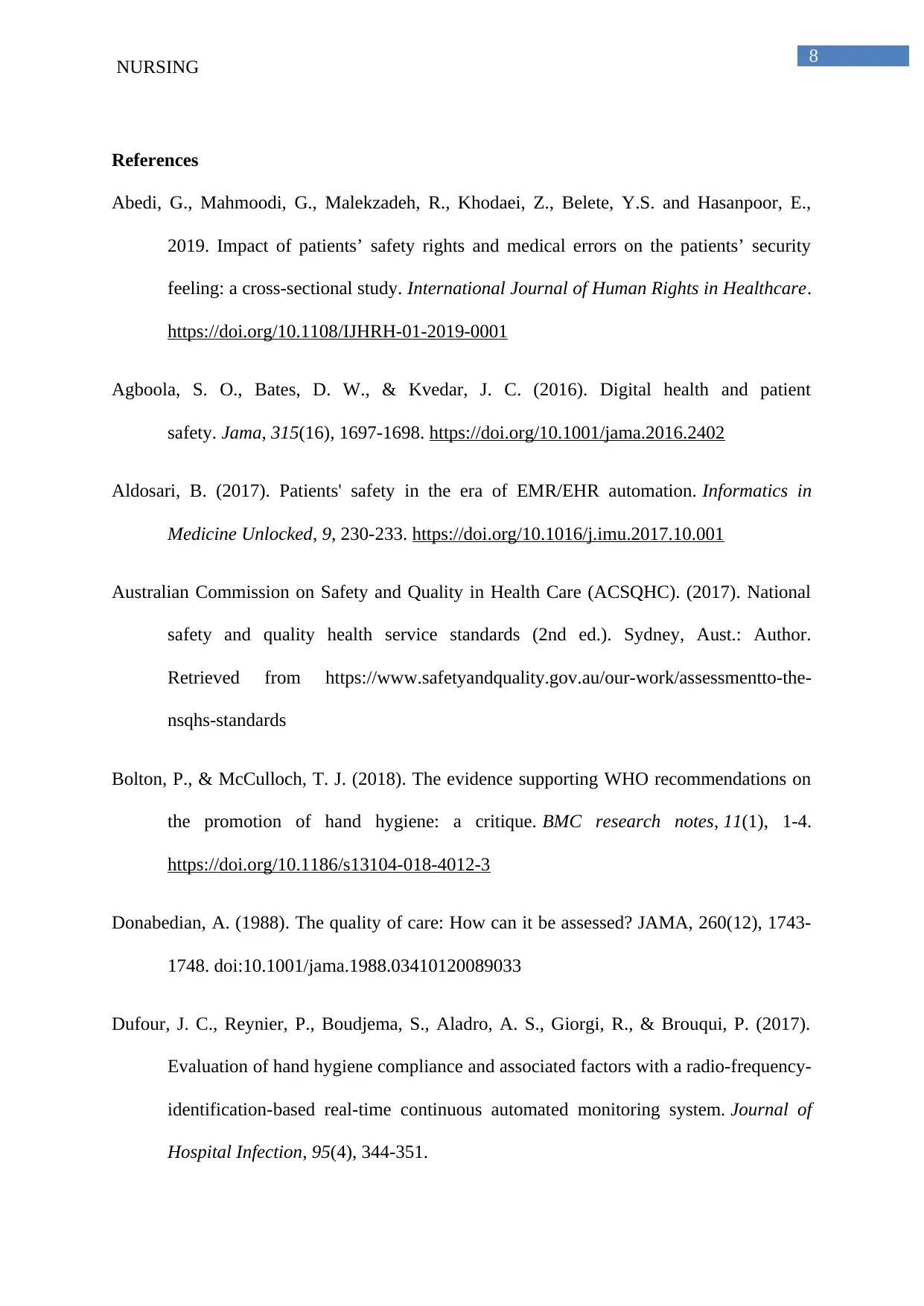
8
NURSING
References
Abedi, G., Mahmoodi, G., Malekzadeh, R., Khodaei, Z., Belete, Y.S. and Hasanpoor, E.,
2019. Impact of patients’ safety rights and medical errors on the patients’ security
feeling: a cross-sectional study. International Journal of Human Rights in Healthcare.
https://doi.org/10.1108/IJHRH-01-2019-0001
Agboola, S. O., Bates, D. W., & Kvedar, J. C. (2016). Digital health and patient
safety. Jama, 315(16), 1697-1698. https://doi.org/10.1001/jama.2016.2402
Aldosari, B. (2017). Patients' safety in the era of EMR/EHR automation. Informatics in
Medicine Unlocked, 9, 230-233. https://doi.org/10.1016/j.imu.2017.10.001
Australian Commission on Safety and Quality in Health Care (ACSQHC). (2017). National
safety and quality health service standards (2nd ed.). Sydney, Aust.: Author.
Retrieved from https://www.safetyandquality.gov.au/our-work/assessmentto-the-
nsqhs-standards
Bolton, P., & McCulloch, T. J. (2018). The evidence supporting WHO recommendations on
the promotion of hand hygiene: a critique. BMC research notes, 11(1), 1-4.
https://doi.org/10.1186/s13104-018-4012-3
Donabedian, A. (1988). The quality of care: How can it be assessed? JAMA, 260(12), 1743-
1748. doi:10.1001/jama.1988.03410120089033
Dufour, J. C., Reynier, P., Boudjema, S., Aladro, A. S., Giorgi, R., & Brouqui, P. (2017).
Evaluation of hand hygiene compliance and associated factors with a radio-frequency-
identification-based real-time continuous automated monitoring system. Journal of
Hospital Infection, 95(4), 344-351.
NURSING
References
Abedi, G., Mahmoodi, G., Malekzadeh, R., Khodaei, Z., Belete, Y.S. and Hasanpoor, E.,
2019. Impact of patients’ safety rights and medical errors on the patients’ security
feeling: a cross-sectional study. International Journal of Human Rights in Healthcare.
https://doi.org/10.1108/IJHRH-01-2019-0001
Agboola, S. O., Bates, D. W., & Kvedar, J. C. (2016). Digital health and patient
safety. Jama, 315(16), 1697-1698. https://doi.org/10.1001/jama.2016.2402
Aldosari, B. (2017). Patients' safety in the era of EMR/EHR automation. Informatics in
Medicine Unlocked, 9, 230-233. https://doi.org/10.1016/j.imu.2017.10.001
Australian Commission on Safety and Quality in Health Care (ACSQHC). (2017). National
safety and quality health service standards (2nd ed.). Sydney, Aust.: Author.
Retrieved from https://www.safetyandquality.gov.au/our-work/assessmentto-the-
nsqhs-standards
Bolton, P., & McCulloch, T. J. (2018). The evidence supporting WHO recommendations on
the promotion of hand hygiene: a critique. BMC research notes, 11(1), 1-4.
https://doi.org/10.1186/s13104-018-4012-3
Donabedian, A. (1988). The quality of care: How can it be assessed? JAMA, 260(12), 1743-
1748. doi:10.1001/jama.1988.03410120089033
Dufour, J. C., Reynier, P., Boudjema, S., Aladro, A. S., Giorgi, R., & Brouqui, P. (2017).
Evaluation of hand hygiene compliance and associated factors with a radio-frequency-
identification-based real-time continuous automated monitoring system. Journal of
Hospital Infection, 95(4), 344-351.
⊘ This is a preview!⊘
Do you want full access?
Subscribe today to unlock all pages.

Trusted by 1+ million students worldwide
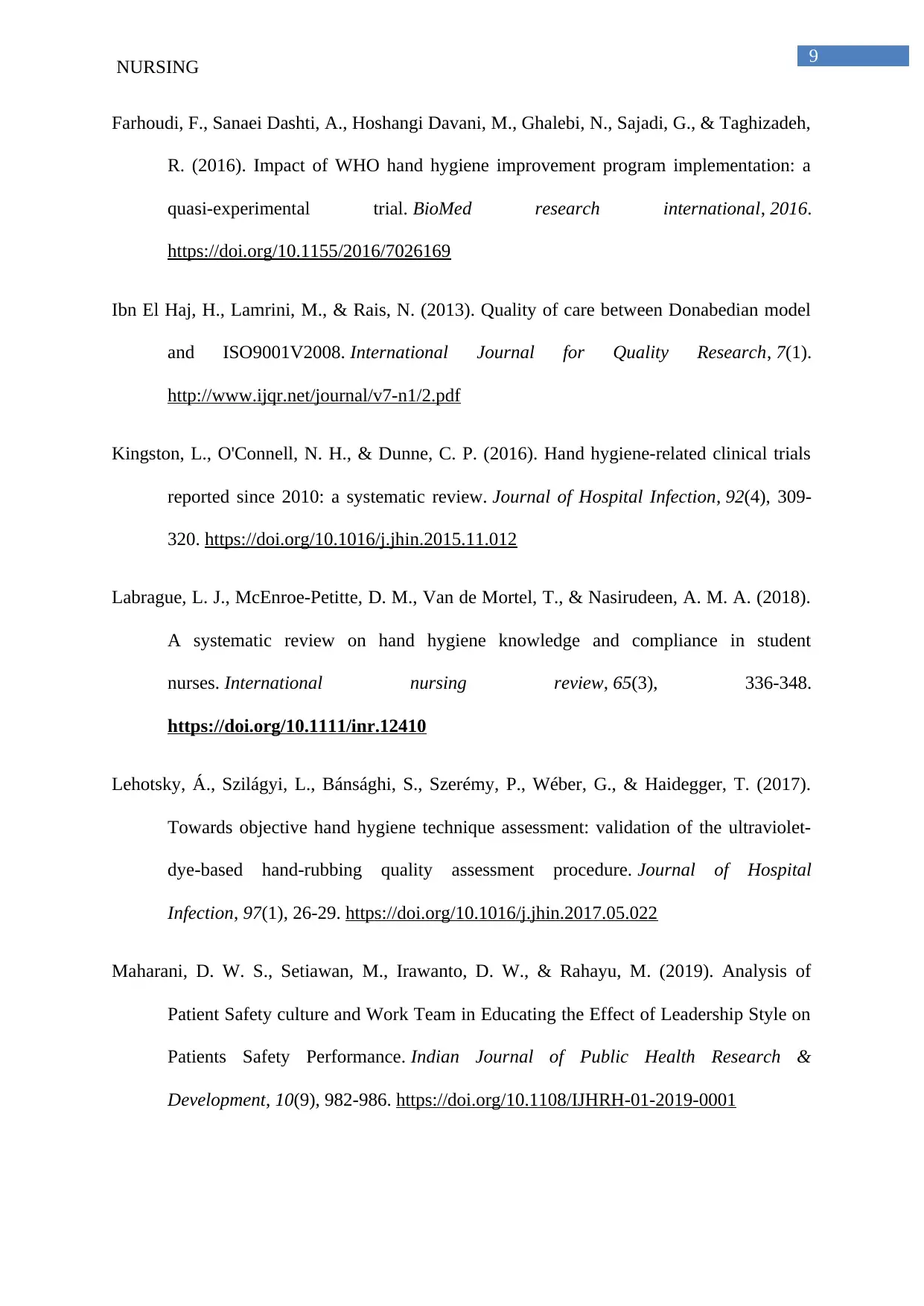
9
NURSING
Farhoudi, F., Sanaei Dashti, A., Hoshangi Davani, M., Ghalebi, N., Sajadi, G., & Taghizadeh,
R. (2016). Impact of WHO hand hygiene improvement program implementation: a
quasi-experimental trial. BioMed research international, 2016.
https://doi.org/10.1155/2016/7026169
Ibn El Haj, H., Lamrini, M., & Rais, N. (2013). Quality of care between Donabedian model
and ISO9001V2008. International Journal for Quality Research, 7(1).
http://www.ijqr.net/journal/v7-n1/2.pdf
Kingston, L., O'Connell, N. H., & Dunne, C. P. (2016). Hand hygiene-related clinical trials
reported since 2010: a systematic review. Journal of Hospital Infection, 92(4), 309-
320. https://doi.org/10.1016/j.jhin.2015.11.012
Labrague, L. J., McEnroe‐Petitte, D. M., Van de Mortel, T., & Nasirudeen, A. M. A. (2018).
A systematic review on hand hygiene knowledge and compliance in student
nurses. International nursing review, 65(3), 336-348.
https://doi.org/10.1111/inr.12410
Lehotsky, Á., Szilágyi, L., Bánsághi, S., Szerémy, P., Wéber, G., & Haidegger, T. (2017).
Towards objective hand hygiene technique assessment: validation of the ultraviolet-
dye-based hand-rubbing quality assessment procedure. Journal of Hospital
Infection, 97(1), 26-29. https://doi.org/10.1016/j.jhin.2017.05.022
Maharani, D. W. S., Setiawan, M., Irawanto, D. W., & Rahayu, M. (2019). Analysis of
Patient Safety culture and Work Team in Educating the Effect of Leadership Style on
Patients Safety Performance. Indian Journal of Public Health Research &
Development, 10(9), 982-986. https://doi.org/10.1108/IJHRH-01-2019-0001
NURSING
Farhoudi, F., Sanaei Dashti, A., Hoshangi Davani, M., Ghalebi, N., Sajadi, G., & Taghizadeh,
R. (2016). Impact of WHO hand hygiene improvement program implementation: a
quasi-experimental trial. BioMed research international, 2016.
https://doi.org/10.1155/2016/7026169
Ibn El Haj, H., Lamrini, M., & Rais, N. (2013). Quality of care between Donabedian model
and ISO9001V2008. International Journal for Quality Research, 7(1).
http://www.ijqr.net/journal/v7-n1/2.pdf
Kingston, L., O'Connell, N. H., & Dunne, C. P. (2016). Hand hygiene-related clinical trials
reported since 2010: a systematic review. Journal of Hospital Infection, 92(4), 309-
320. https://doi.org/10.1016/j.jhin.2015.11.012
Labrague, L. J., McEnroe‐Petitte, D. M., Van de Mortel, T., & Nasirudeen, A. M. A. (2018).
A systematic review on hand hygiene knowledge and compliance in student
nurses. International nursing review, 65(3), 336-348.
https://doi.org/10.1111/inr.12410
Lehotsky, Á., Szilágyi, L., Bánsághi, S., Szerémy, P., Wéber, G., & Haidegger, T. (2017).
Towards objective hand hygiene technique assessment: validation of the ultraviolet-
dye-based hand-rubbing quality assessment procedure. Journal of Hospital
Infection, 97(1), 26-29. https://doi.org/10.1016/j.jhin.2017.05.022
Maharani, D. W. S., Setiawan, M., Irawanto, D. W., & Rahayu, M. (2019). Analysis of
Patient Safety culture and Work Team in Educating the Effect of Leadership Style on
Patients Safety Performance. Indian Journal of Public Health Research &
Development, 10(9), 982-986. https://doi.org/10.1108/IJHRH-01-2019-0001
Paraphrase This Document
Need a fresh take? Get an instant paraphrase of this document with our AI Paraphraser
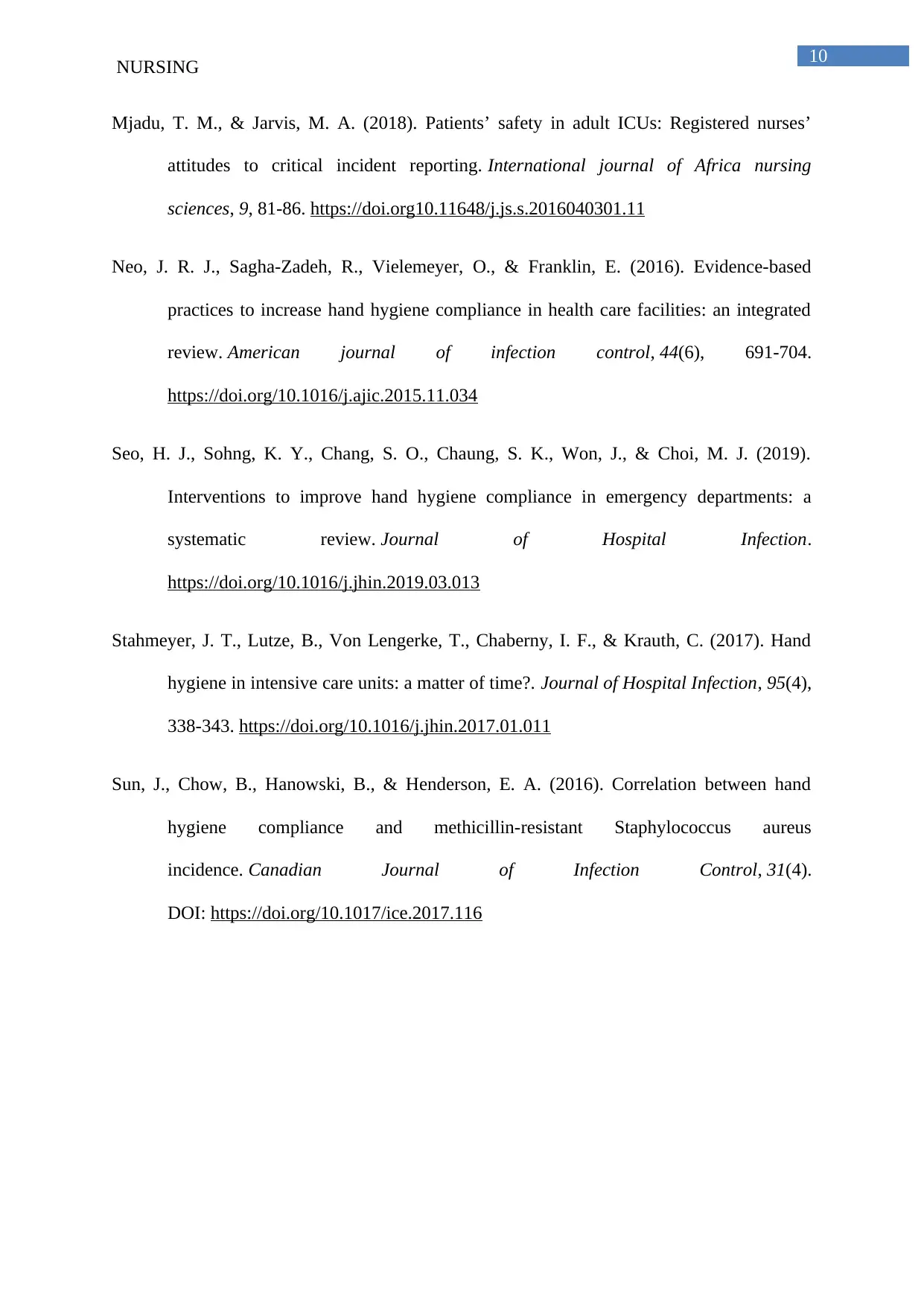
10
NURSING
Mjadu, T. M., & Jarvis, M. A. (2018). Patients’ safety in adult ICUs: Registered nurses’
attitudes to critical incident reporting. International journal of Africa nursing
sciences, 9, 81-86. https://doi.org10.11648/j.js.s.2016040301.11
Neo, J. R. J., Sagha-Zadeh, R., Vielemeyer, O., & Franklin, E. (2016). Evidence-based
practices to increase hand hygiene compliance in health care facilities: an integrated
review. American journal of infection control, 44(6), 691-704.
https://doi.org/10.1016/j.ajic.2015.11.034
Seo, H. J., Sohng, K. Y., Chang, S. O., Chaung, S. K., Won, J., & Choi, M. J. (2019).
Interventions to improve hand hygiene compliance in emergency departments: a
systematic review. Journal of Hospital Infection.
https://doi.org/10.1016/j.jhin.2019.03.013
Stahmeyer, J. T., Lutze, B., Von Lengerke, T., Chaberny, I. F., & Krauth, C. (2017). Hand
hygiene in intensive care units: a matter of time?. Journal of Hospital Infection, 95(4),
338-343. https://doi.org/10.1016/j.jhin.2017.01.011
Sun, J., Chow, B., Hanowski, B., & Henderson, E. A. (2016). Correlation between hand
hygiene compliance and methicillin-resistant Staphylococcus aureus
incidence. Canadian Journal of Infection Control, 31(4).
DOI: https://doi.org/10.1017/ice.2017.116
NURSING
Mjadu, T. M., & Jarvis, M. A. (2018). Patients’ safety in adult ICUs: Registered nurses’
attitudes to critical incident reporting. International journal of Africa nursing
sciences, 9, 81-86. https://doi.org10.11648/j.js.s.2016040301.11
Neo, J. R. J., Sagha-Zadeh, R., Vielemeyer, O., & Franklin, E. (2016). Evidence-based
practices to increase hand hygiene compliance in health care facilities: an integrated
review. American journal of infection control, 44(6), 691-704.
https://doi.org/10.1016/j.ajic.2015.11.034
Seo, H. J., Sohng, K. Y., Chang, S. O., Chaung, S. K., Won, J., & Choi, M. J. (2019).
Interventions to improve hand hygiene compliance in emergency departments: a
systematic review. Journal of Hospital Infection.
https://doi.org/10.1016/j.jhin.2019.03.013
Stahmeyer, J. T., Lutze, B., Von Lengerke, T., Chaberny, I. F., & Krauth, C. (2017). Hand
hygiene in intensive care units: a matter of time?. Journal of Hospital Infection, 95(4),
338-343. https://doi.org/10.1016/j.jhin.2017.01.011
Sun, J., Chow, B., Hanowski, B., & Henderson, E. A. (2016). Correlation between hand
hygiene compliance and methicillin-resistant Staphylococcus aureus
incidence. Canadian Journal of Infection Control, 31(4).
DOI: https://doi.org/10.1017/ice.2017.116
1 out of 11
Related Documents
Your All-in-One AI-Powered Toolkit for Academic Success.
+13062052269
info@desklib.com
Available 24*7 on WhatsApp / Email
![[object Object]](/_next/static/media/star-bottom.7253800d.svg)
Unlock your academic potential
Copyright © 2020–2025 A2Z Services. All Rights Reserved. Developed and managed by ZUCOL.





